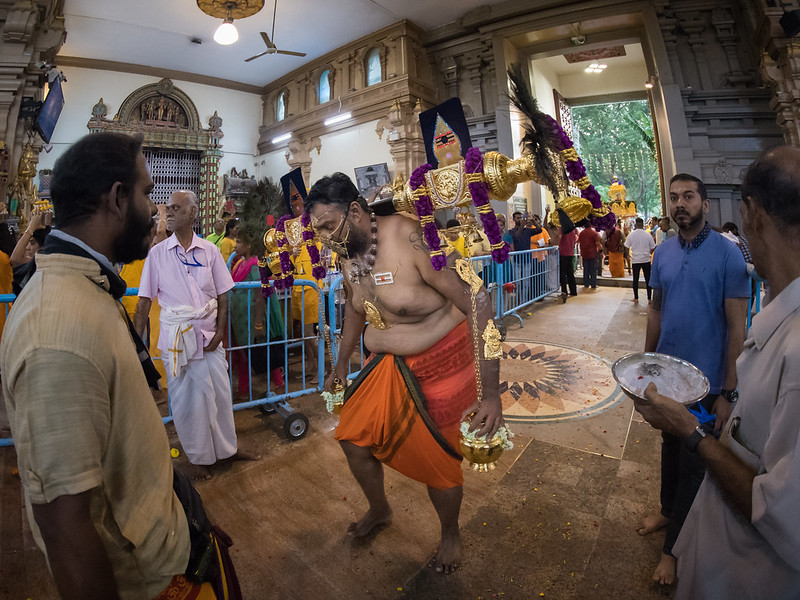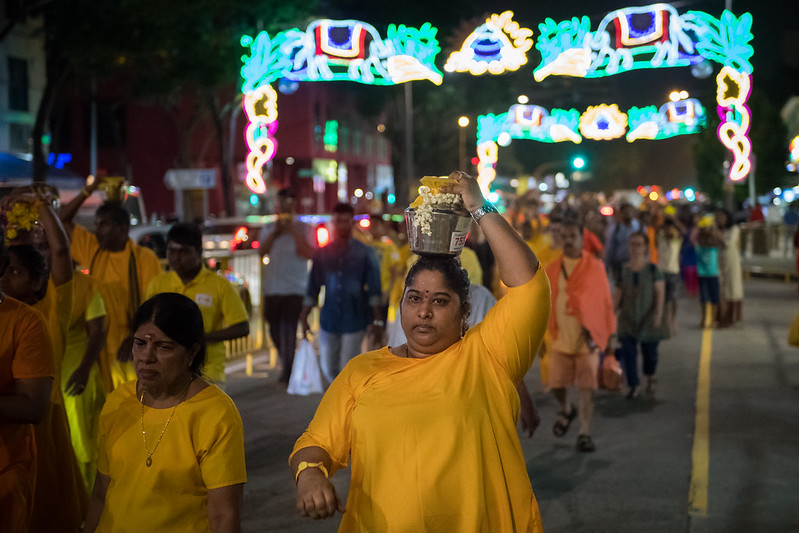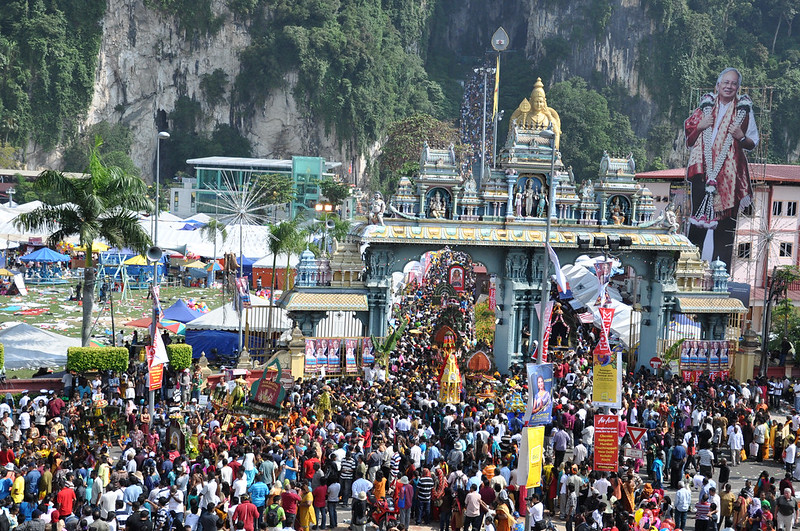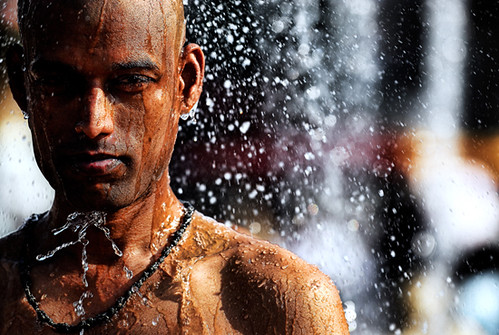Thaipusam
A Pilgrimage of Prayer and Penance Illuminates Batu Caves
2026/01/31
Every year from late January to early February, Malaysia’s Thaipusam transforms Batu Caves and temples nationwide into a riot of color, music, and fervent devotion. Held in Kuala Lumpur, Penang, and other cities, the festival draws over a million devotees and visitors, making it one of the world’s most spectacular religious events. For lovers of culture, photography, or anyone seeking an extraordinary, immersive experience, Thaipusam is a festival that stirs every sense.
The heart of the festival is Batu Caves, where the world’s tallest Murugan statue stands watch. Barefoot pilgrims walk 15 kilometers and climb 272 steep steps, surrounded by the rhythms of drums and chimes, the scent of incense and flowers, and the collective energy of the crowd. The atmosphere is nothing short of electrifying.
Main Attractions
The Grand Procession to Batu Caves and Kavadi Rituals
The signature of Thaipusam is the grand midnight procession from Sri Maha Mariamman Temple to Batu Caves, covering 15 kilometers. Devotees chant “Vel, Vel,” moving to the beat of drums and trumpets, as the air fills with the scent of flowers, incense, and coconut water. The journey is charged with heat, prayer, and anticipation.
Upon reaching Batu Caves, the festival reaches its peak. Pilgrims carry towering kavadis-ornate offerings decorated with peacock feathers and flowers-on their shoulders, and some pierce their cheeks, tongues, or skin with hooks and skewers as acts of penance. Many carry milk pots or fruit above their heads, and others shave their heads in a sign of humility. The sight of devotees ascending all 272 steps is awe-inspiring.
Costumes, Decorations, and Festival Atmosphere
Thaipusam is truly a feast for the senses. Devotees wear yellow and orange-the sacred colors of Lord Murugan-and adorn themselves with garlands and flower necklaces. Kavadis can reach 4 meters high and weigh up to 35 kg, decorated with peacock feathers, fruit, and dazzling ornaments. Temples and streets are festooned with banana trees, marigolds, and vibrant flags, while the sounds of drums, bells, and prayers fill the air. Families, tourists, and worshippers mingle in a shared atmosphere of energy and unity.
Cultural and Historical Background
Thaipusam is a major Hindu festival held on the full moon of the Tamil month of Thai (late January to early February), when the brightest star “Pusam” is at its zenith. Its origins lie in Hindu mythology: the goddess Parvati gave her son, Lord Murugan, a sacred spear (vel) to defeat the demon Soorapadman. Thaipusam is a day to give thanks for this victory and divine protection. Devotees seek purification, fulfillment of vows, and blessings for family health and prosperity, deepening their faith through penance, fasting, and vows.
In Malaysia, Thaipusam spread in the late 19th century with the arrival of Indian immigrants. Batu Caves became the festival’s sacred site after a Hindu temple was established there in 1892. Today, Thaipusam is celebrated nationwide, with Kuala Lumpur, Penang, and Ipoh even designating it a public holiday. The festival has grown dramatically, with over a million pilgrims and visitors gathering at Batu Caves, making it one of Southeast Asia’s largest religious gatherings.
Thaipusam is more than a religious ritual-it is a symbol of coexistence and diversity in Malaysia’s multiethnic, multifaith society. Not only Hindus, but people of all backgrounds and tourists join in, experiencing the power of faith, art, and community. The festival’s blend of kavadi offerings, acts of penance, music, decorations, and vegetarian cuisine creates a unique fusion of devotion and creativity. For devotees, Thaipusam is a life milestone, deepening family and community bonds. Through Thaipusam, Malaysia’s spirit of tolerance, diversity, and spiritual strength is shared with the world.
Participant Voices
“As a first-time visitor, I was overwhelmed by the colors, sounds, and depth of faith. I spoke with a woman carrying a milk pot, who told me she was giving thanks for her son’s recovery from illness. The warmth of the community was deeply moving.”
Fun Facts
- Over a million people visit Batu Caves for Thaipusam each year, making it one of Southeast Asia’s largest religious events.
- Kavadis can weigh up to 35 kg and reach 4 meters high, crafted by the devotees themselves.
- Devotees observe vegetarian diets and abstinence for 48 days before the festival to purify body and mind.
- Yellow and orange are the symbolic colors of Lord Murugan, representing purity and strength.
Festival Dates
Thaipusam is held annually on the full moon between late January and early February, with the main celebrations at Batu Caves in Kuala Lumpur, as well as temples in Penang, Perak, and other regions. Experience this awe-inspiring pilgrimage, penance, and vibrant festival of faith and color for yourself.
The event schedule is subject to change. Please check the official website for the most up-to-date information.
Information
| Name | Thaipusam |
| Country | Malaysia |
| Area | Batu Caves (Selangor), Waterfall Temple (Penang) |
| Date | 2026/01/31 |
| Link |
Upcoming Festivals
Whirling Dervishes Festival Turkey
A Mesmerizing Dance of Divine Love
2025/12/06Mevlana Celaleddin Rumi Commemoration Ceremony ( Şeb-i Arus ) Turkey
A Whirling Journey to Divine Love
2025/12/10Dia de la Virgen de Guadalupe Mexico
A Festival Weaving Faith, Fervor, and Mexican Identity
2025/12/11L'Escalade Switzerland
Geneva’s Grand Winter Festival of Courage, Chocolate, and Community
2025/12/12Umkhosi Wokweshwama South Africa
The Zulu First Fruits Festival—A Sacred Celebration of Land, Ancestors, and Renewal
2025/12/12Lucia Festival (St. Lucia's Day) Sweden
A Festival of Light Illuminating the Nordic Darkness
2025/12/15Las Posadas Mexico
The Luminous Quest for Sacred Shelter
2025/12/22Noche de Rabanos (Night of the Radishes) Mexico
A celebration blending art, farming heritage, and cultural traditions
2025/12/23Chant of the Sybil on Majorca Spain
A Medieval Prophecy Echoes Through Majorcan Christmas
2025/12/23‘Hatajo de Negritos’ and the ‘Hatajo de Pallitas’ Peru
A Christmas Festival of Rhythm, Faith, and Afro-Andean Heritage in Peru’s Ica Region



